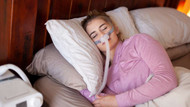While an initial diagnosis of sleep apnoea can be scary, the good news is that it is easily treatable with a range of treatment options available.
We explore your different treatment options around sleep apnoea and how you can decide which one is best for you.
What are my treatment options if I’ve been diagnosed with sleep apnoea?
There are a variety of treatments available, ranging from lifestyle changes to surgery.
Lifestyle changes
Some lifestyle changes you can introduce include:
-
Reducing the amount you drink
-
Reducing the amount you smoke
-
Losing weight, as it can improve your sleep apnoea1
However, the effectiveness of weight loss depends on how severe your sleep apnoea is.
In people with mild-to-moderate obstructive sleep apnoea, a 10 per cent weight reduction is known to improve sleep apnoea symptoms and sleep quality.
In people with severe obstructive sleep apnoea, the benefits are less clear 2.
Continuous Positive Airway Pressure (CPAP) devices
The most effective treatment available for sleep apnoea is a CPAP mask worn while sleeping called a Continuous Positive Airway Pressure (CPAP) device2.
CPAP devices generate positive air pressure that keeps the upper airway open while resting.
Despite its highly effective treatment of sleep apnoea, it’s poorly tolerated, with roughly 50 per cent of people using the device unable or unwilling to use CPAP in the long term3.
Oral appliances, such as dental devices
Dental devices, such as a specially made mouthguard like a mandibular advancement splint, prevent airway obstruction by moving the lower jaw forward.
These devices can provide some success for people with mild to moderate obstructive sleep apnoea 4 and can also be used in severe cases of sleep apnoea if you can’t tolerate CPAP.
The dental device aims to move the tongue forward, which keeps the tongue from obstructing your throat as you rest.
These devices can be made by a dentist who is experienced in the treatment of obstructive sleep apnoea.
However, they cannot be used in people who do not have their natural teeth or teeth in poor condition.
There are also some negative side effects with this device, as you can suffer from tender teeth and excessive saliva formation 5.
Positional devices
Some people only suffer from sleep apnoea symptoms when they sleep on their backs. Some measures you can take to prevent sleeping on your back include 1:
-
Mechanical devices, which use pillows or cushions
-
Electronic devices which alert you when you’re sleeping on your back
Surgical Treatments
Surgical treatments for sleep apnoea are less common than nonsurgical treatments.
There are a range of surgical treatments available, including 6:
-
Nasal surgery: This operation aims to increase airflow through the nose, but does not completely cure sleep apnoea. It may improve your daytime and nighttime breathing through your nose and help CPAP work more efficiently.
-
Upper Airway Surgery: The most common operation performed is called a uvulopalatopharyngoplasty, which attempts to widen your airway behind the tongue and removes excess tissues and the uvula. Although snoring is improved, roughly 40 per cent of patients who undergo this operation resolve or see major improvements in their sleep apnoea.
-
Maxillomandibular Advancement (MMA): This operation surgically fractures the upper and lower jaws to enlarge the airways. However, this operation isn’t commonly used due to greater patient risk and a longer recovery period than Upper Airway Surgery.
If you want surgical treatment for your sleep apnoea, please speak with your doctor about the different types of procedures available, their risks and their success rates before making a final decision.
Is there one treatment that works better than the other?
CPAP is the most consistently successful and commonly used method of treating obstructive sleep apnoea 1.
However, with 50% of patients not sticking with CPAP therapy due to the device being poorly tolerated, the most effective treatment is the one you can stick with.
For some, they may find success with CPAP therapy. Others might find that lifestyle changes, such as losing weight and not sleeping on their back, can help ease their sleep apnoea symptoms.
Working with your general health practitioner to find the best treatment option that works for you and your lifestyle is vital to treat your symptoms of obstructive sleep apnoea.
References
1Better Health Victoria, Treatment for sleep apnoea, accessed 30 March 2023
2Royal Australian College of General Practitioners, Obstructive sleep apnoea and obesity, accessed 30 March 2023
3Weaver TE, Grunstein RR. Adherence to continuous positive airway pressure therapy: The challenge to effective treatment. Proc Am Thorac Soc 2008;5:173–78.
4Division of Sleep Medicine, Harvard Medical School, Non Surgical Options for treatment of sleep apnoea, accessed 30 March 2023
5Royal Australian College of General Practitioners, Mandibular advancement devices: obstructive sleep apnoea, accessed 30 March 2023
6Division of Sleep Medicine, Harvard Medical School, Surgical Options for treatment of sleep apnoea, accessed 30 March 2023

